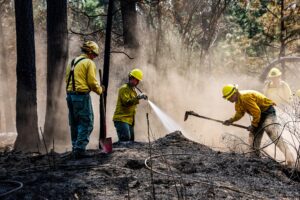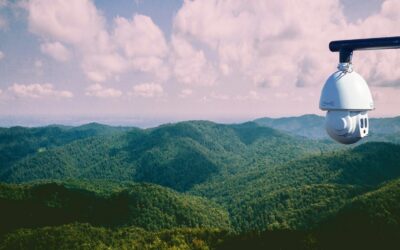Feb. 6—The Gray fire that devastated Medical Lake in August was caused by sparks from an Inland Power and Light security light mounted to a pole, a Department of Natural Resources investigation found.
Multiple lawsuits have already alleged that Inland Power was at fault.

Mason County Strike Team mopping up in Gray Fire (Photo: Morgan Rubanow – Inciweb)
Inland Power directed questions on the report to the company’s attorney, Scott Cefriese, who said they are still reviewing the report. Inland Power does not typically comment on pending litigation, Cefriese said.
He added that Inland Power responded to DNR’s questions during the investigation.
“We were very open with the DNR in their investigation and we helped them along the way,” Cifriese said.
The investigation found that sparks from the light on Aug. 18 ignited nearby brush.
“It was determined that the Gray fire was caused by an arcing wire/connector on the Inland Power Pole mounted security light,” the report reads. “The sparks were blown into the seasonally cured grasses, at the base of a tree, across the gravel driveway from the Inland Power Light.”
A resident of the property where the fire started said she had called Inland Power several times to report the light had been “flickering” since it was installed, but no one had come out to the property to check on it, according to the report.
The fire burned 10,000 acres, 240 homes and displaced thousands of people.
Together with the damage caused by another fire on Aug. 18 near the town of Elk, it will cost more than $5 billion to repair and rebuild, according to a letter sent by Gov. Jay Inslee to the federal government.
The investigation
DNR investigators were called to the fire shortly after it was reported and arrived at the command post by 3 p.m.
The investigator, John McDonald, went out to 12605 S. Gray Road, where the fire was reported.
There, he saw a V pattern burn. Typically, the ignition area of a fire is near the apex of the V shape, he wrote in his report.
The V shape emanated from a tree on the east side of the driveway.
He spoke with one of the residents, Candy Grauberger, who said she had been sleeping at the time of the fire. She was awakened by someone “banging on her door and yelling fire.” She ran outside and saw it had already burned past the barns and was headed toward Medical Lake.
As she watched firefighters and passersby try to put out the fire, she said she saw sparks coming from the power pole..
Grauberger called Inland Power and Light and was put on hold for about 10 minutes before she passed along what she had seen. About 15 or 20 minutes later, Inland Power arrived and disconnected power from the light and then left the area, she told investigators.
Grauberger said that earlier in the summer she had called at least twice to report the light was flickering, and she thought there might be a loose wire.
David Yuhas and Terrell Cole also encountered the Gray fire in the afternoon it began. Along with their sons, Yuhas and Cole were coming out to the property used by Jensen Memorial Youth Ranch and owned by founder Carl Grub, when they saw smoke, according to the report.
They were the ones who knocked on Grauberger’s door. Yuhas then used a tractor to try and contain the fire, but a gust of strong wind drove the fire uphill faster than he expected, according to the report.
Not long after, firefighters arrived on scene. Yuhas continued to help with fire containment. About 20 minutes later, he heard a woman yelling that there were sparks falling from the power pole.
He didn’t see any sparks but saw what appeared to him to be a loose connection at the junction box where the line met the pole, he told investigators.
Yuhas contacted Inland Power, who told him crews were already responding to shut off power.
Before leaving, Yuhas spoke with Grub, who thanked them for saving his well house and barns, according to the investigation.
Grub died later that afternoon in the blaze after crashing his truck while driving back to Medical Lake.
Another witness, Keith Hodgson, said he saw smoke and came over to the area at about 12:15 p.m. with his tractor to help with fire control. He, too, saw sparks coming from the light pole.
McDonald, the DNR investigator, went to the power pole with the light attached to it when he arrived and blocked off the area. He didn’t see burnt material at the base of the power pole. The fire’s edge was about 20 feet from the base of the pole on the east side of the driveway, McDonald wrote.
Inland Power came back out at McDonald’s request and disconnected the light and some wiring, which investigators took possession of.
Investigators later discovered the first Inland Power crew on scene had removed three items from the light. Those items were two pieces of insulation and an approximately 5-inch piece of aluminum conductor. Inland Power’s attorney, Cifrese, said he had the items.
Investigators photographed them, then allowed Inland Power to keep the items to be examined in a nondestructive way by their experts before being turned over to DNR, according to the report.
Investigators said they made several attempts to collect the evidence from Cifrese, Inland Power’s attorney. Eventually, Cifrese responded to investigators and said the items were still in California at a laboratory Inland Power had retained.
Cifrese said the evidence was available for pickup on Oct. 5. Three days later, when investigators went to pick up the evidence, they found one piece missing — an aluminum conductor with cut marks on one end and melted aluminum on the other. It was not in the box, according to the DNR investigation.
The attorney called the California lab, which said it only received the two pieces.
“Mr. Cifrese told me he had no idea what had happened to the missing conductor piece but that he would look for it in his office and if he found it, he would ensure that the DNR would regain custody of it,” the report reads.
Cifrese did not dispute that the piece of evidence had gone missing. DNR included photographs of the conductor in it’s report.
Investigators noted one report alleging that Grub, who owned the property, was using a welder and angle grinder on a horse trailer when the fire started. But they determined there was “no evidence of a horse trailer, no signs of welding or grinding were discovered at or near the origin of the fire.”
Yuhas and Grauberger told investigators that Grub, who was 86, needed a walker and that doing any type of metal work was “not in his normal capacity.” Furthermore, Grauberger told investigators that the ranch’s horse trailers were at a different location.
Investigators concluded that the fire started when sparks from the light were blown into dry grass and brush at the base of a nearby tree about 36 feet from the light pole.
Due to weather conditions, the fire quickly spread.
The results of the investigation were forwarded to the Washington State Attorney General’s Office.
In high-cost fires where the investigation results in a clear cause, DNR will often forward the results to the attorney general, said Thomas Kyle-Milward, communications manager for DNR wildfire.
The attorney general then reviews the investigation for potential litigation to recover the costs of fighting the fire.
Spokane attorney John Allison, who is representing dozens of people affected by the fire in a lawsuit against Inland Power, made similar allegations in court filings that it was an Inland Power light pole that caused the blaze.
“I think it’s certainly an endorsement of the investigative efforts that we’ve undertaken and a confirmation of our findings,” Allison said Tuesday.
Gerald Singleton with Singleton Schreiber, another law firm that filed a separate suit against Inland Power, said that while more information is needed, the report was helpful.
“It’s very important, because when you start these things off, you suspect that, you know, but you haven’t seen all the evidence yet,” Singleton said. “Any time you get a report like this that’s prepared by an experienced investigator … and that person says that it was caused by the defendant, that’s very helpful.”
___
(c)2024 The Spokesman-Review (Spokane, Wash.)
Visit The Spokesman-Review (Spokane, Wash.) at www.spokesman.com
Distributed by Tribune Content Agency, LLC.




